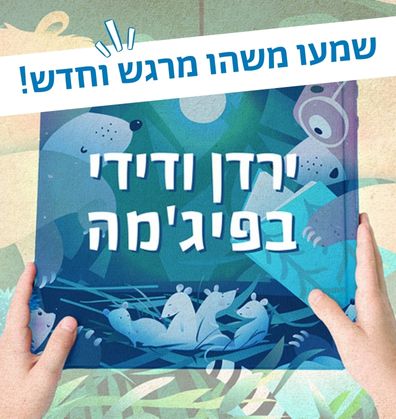חַגִּים וְיָמִים מְיֻחָדִים
ט"ו בשבט
ט"ו בשבט הגיע – חג לאילנות! וגם לנו בני האדם זה חג של עצים, צמיחה ושמירה על הסביבה. לכבוד ט"ו בשבט הכנו עבורכם כמה הצעות לחגיגה משפחתית:
סְּפָרִים
Book-Related Family Activities
This is How We Plant a Seedling
You can also plant at home or in the garden: Dig a hole in the ground, place the seedling inside, tighten the soil around it, and water it. Not sure how to plant? Follow the instructions in the book…
Movement – How does a seedling grow?
It is a good idea to demonstrate with body movements how a seedling grows: bend low, straighten up slowly, stand on your tiptoes and finally, raise your arms up and sideways.
Game: Quickly-Slowly
“How do you plant a seedling? Neither fast nor slow.” You can have fun with quickly or slowly: “Now we will walk… quickly. And now… slowly!” “Let’s roll our hands… slowly, and let’s roll our hands… quickly!” What else can you do quickly and slowly?
Song – “This is how we plant a seedling”
“This is how we plant a seedling” is a song with a melody composed by Mati Caspi. You can sing it together with movements, dance and clapping of hands.
Scan the QR code to upload the song and sing together.
A discussion on stories that “once were”
Following this book, you could also raise memories and tell stories that “once were” – a childhood story of yours, parents, or one told by Grandma or Grandpa about the old days.
Listening to the story
You could listen to the story together or separately; all you have to do is scan the QR code and… let the magic begin!
Suitable for families of Olim too.
Look how we have grown!
The tree grew, as did Rebecca. And how about you? Perhaps you would enjoy watching videos and looking at photographs to see how both children and parents have grown and changed. You could even discuss the kinds of actions that your children were able or unable to do in the past.
Orange sponge cake
Would you like to bake a cake? All you need are two eggs, one third of a cup of sugar, one third of a cup of oil, half a cup of fresh orange juice, a cup of flour (or substitute) and one teaspoon of baking powder. You could also add the grated zest of half an orange.
Mix all the ingredients in order and place in an oven preheated to 180 degrees Celsius. Bon Appetit!
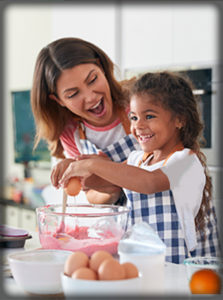
Discussion – What does it mean to be considerate?
“It’s important to be considerate toward our environment” – What does being considerate mean? How can we be more considerate of one another at home, within our own family? And how can we care for our environment? You could discuss these questions with your child, and come up with suggestions on how to be more considerate of other people as well as the environment.
An invitation for an observation
You’re most invited to embark on an observation on a piece of nature in your immediate surroundings: A park near your home, or field, or yard, or even a planter on your balcony. What would you discover if you sat down quietly and watched? You may want to bring a magnifying glass along with you.
Learning from one another
What can adults learn from children? Lots of things! How to play their favorite game, engage in arts & crafts, find out more about a subject they learned about in preschool, or just share an interesting thought. And what can children learn from adults? To find out what we can learn from one another, all we have to do is sit together, and pay attention.
Catching colors
The sky is blue, the earth is brown, and vegetation is green. You may enjoy going outdoors and “catching colors”: Take turns to say a color, while the other players quickly find an item around them that is the same color, and point to it.
Discussion
Do you, much like the pine tree, feel lonely sometimes? Have you ever seen a boy or girl who seemed a little lonely? You may want to discuss this feeling of “being all alone” and what we could do when we – or those around us – feel this way.
Some information on pine trees
The Jerusalem Pine (more commonly known in English as the Aleppo Pine) is the species of pine trees that grows in Israel. It is highly prevalent in the Carmel and Judea Mountains areas. As the Jewish community, the Yishuv, grew, it began to plant large pine tree forests in the Land of Israel. The pine tree contains resin, and in springtime, its branches are densely filled with pinecones. Would you like to learn more about the pine tree? Feel free to look for images and additional information online.
The next chapter
What will happen once the trees grow and a forest is created? Will they be friends with the pine tree? Will other friends come and visit? And what will the children do in the new forest? – You may enjoy discussing the next chapter of the book, acting it out, or drawing it together.
A game – Who am I?
Am I the wind blowing? Or the falling rain? Perhaps a leaping rabbit? You could play a form of charades by taking turns miming one of the characters in the book, and having the others try to guess which one you’ve chosen.
How to adopt a tree
How about picking a tree in your area and taking care of it? You could clean around it, place a mat under it, and observe the small animals that use it as part of their habitat. If you look carefully, you may even catch it smiling.
Datia Ben Dor
Born in Alexandria, Egypt in 1944, and immigrated to Israel when she was a year old. During her early professional career, Ben Dor engaged in musical education, writing screenplays and songs for many TV shows for preschoolers, such as Parpar Nechmad (Lovely Butterfly) and the Israeli version of Sesame Street. Many of her children’s songs and books are very well-known and loved, among them: Ani Tamid Nishar Ani (Me is Me), Digdugim (Tickles), Otiyot Mefatpetot (Chatty Alphabet), and Kacha Zeh BeIvrit (That’s How Hebrew Is). Datia Ben Dor won awards for her contribution to children’s literature, such as the ACUM Award and Bialik Prize for Lifetime Achievement in Children’s Literature.
Proposed Family Activities:
- The child in this book asks the tree what it is like to be a tree. It may be interesting to discover your own child’s answer to the question: What is it like to be a child? What makes you special, and what makes you happy?
- Itay Bekin, the illustrator, added details that are not explicitly mentioned in the text of the story. Can your child identify all that is found underground, by the tree’s roots? Who makes frequent appearances in the illustrations, flying around throughout the book?
- The tree is happy to be rooted to a single spot, hear the birds chirping, and feel the dew falling. Perhaps you would enjoy playing “kind eye” with your child – look out the window together, look for good things, and share them with each other. You can then look inside the house, and continue playing by taking turns to tell each other what is good about your home and family, and what it is you like about them.
- You could go tree-spotting near your home. Try to notice which trees are growing in your area: Are they decorative or fruit-bearing? How can you tell whether they are young or old? Perhaps you could pack this book, a blanket and some refreshments, and read the story together in nature, under your favorite tree.
- Trees are very useful to us. You may enjoy walking through your home and looking for everything that is made from trees (wood) or their fruit. For instance: some of your furniture may be made of various kinds of wood; paper is made of wood shavings, as are books; olive oil is used for cooking and candle-lighting; wine and raisins come from grapes that grow on vines, and so on.
- Datia Ben Dor has written many well-loved stories and poems. You may want to look for them at home or the local library, and read them together.
Proposed Family Activities:
- How about packing this book along with some refreshments and a blanket, finding a beloved tree in nature, and reading the story there together. Afterwards, you may enjoy collecting pine cones, tree bark, leaves, and more. When you return home, you can use them to make a piece of artwork together.
- You may want to snuggle up and look at the magnificent illustrations closely. Can your child identify some familiar trees by their illustration?
- After you finish reading the story, you may want to ask your child what they think Giora will do now, and what will happen to the trees. Perhaps you would enjoy writing up a creative follow-up to the story told, and illustrating it.
- Baobab, loquat, Tamarisk, Pecan… Giora knows every tree by name. what kinds of trees grow near your home? How can you identify them? How can you tell them apart? You may want to take go tree-spotting together, learn about the trees you see, and make an illustrated tree guide together.
- How about taking a walk near your home? Are there any open spaces or dilapidated courtyards nearby? Perhaps you and some friends could clean them up, and make them look nicer. You could even plant a community garden with your neighbors.
- Do you know any other stories or poems about trees (like Zuta and the Apple Tree by Orit Raz, What’s it like to be a Tree? By Datia Ben Dor, The Abba Tree by Devora Busheri, What Does it Take by Gianni Rodari)? You may want to look for them at home or in the library, and read them together.
This is the last book your child will receive from PJ Library this year. We hope you have enjoyed reading, discussing, and doing the activities together. We wish you a summer full of wonderful experiences and story times. See you next year!
"Who's there, in the bag?"
You may enjoy giving each character in the story a different voice, and amusing yourselves with the words and rhymes. After you have read the story several times, your child could recognize the various fruit using the illustrations, and answer the rhyming question Dfik Dfok Dfik! Mi Sham Basakik? (“Knock, rap, bang! Who there, in the bag?”)
Going to market
Has your child ever tasted a carob or fig? Do they like oranges and bananas? You may like to take them with you to the market or supermarket, let them choose the fruit they like, and put them into your basket or bag. Together, you could make a fruit salad when you return home.
Six in a Bag, the Musical!
You may want to draw and color the fruit featured in this story, stick your drawings on popsicle sticks, and act the story out together.
Comparing apples and oranges – the tasting test
How do we recognize fruit? By their color, smell, or flavor? You may enjoy playing this guessing game: ask your child to close their eyes, and give them a piece of fruit to smell. Can they guess what it is? Let them taste it with their eyes closed. Do they recognize the flavor?
The bag in the story flies off with the wind
The bag in the story flies off with the wind. Has your child ever seen a bag tossed in the street? You could put it in the garbage can together, and help the environment. This may be a good opportunity to remind your child never to play with plastic bags!
Levin Kipnis (1894–1990)
Levin Kipnis wrote and translated hundreds of literary pieces for children, having set up and managed the first children’s theater in Israel. He also edited numerous journals, anthologies and textbooks.
For lack of holiday songs and stories in Hebrew suitable for young children, Kipnis proceeded to compile kindergarten curricula, and author much-loved children’s stories and poems on Jewish holidays, such as Svivon Sov Sov Sov (“Spin Spin Spin, Dreidel”) for Hanukkah, Ani Purim (“I am Purim”) for Purim, and Saleinu Al Ktefeinu (“Our Baskets are upon our Shoulders”) for Shavuot. His literary pieces contain messages of helping and consideration of others, such as in the famous Eliezer Vehagezer (“Eliezer and the Carrot”), Hamitriya Hagdola shel Abba (“Daddy’s Big Umbrella”), and Shloshet Haparparim (“The Three Butterflies”).
Levin Kipnis was a particularly prolific author, and won many awards, including the Israel Prize and Hans Christian Andersen Award.
Family reading tips
Adrianus (Hadrian) was a Roman emperor from 117 to 138. The Roman empire thrived under his reign. Adrianus suppressed the Bar Kokhba revolt and enacted regulations against the Jewish people. In the Talmudic legends (Midrashim) he is described as a wise and well-educated emperor, but also as being cruel. He is often cited as the main cause of the destruction of Judea.
Basket full of gifts
Special gifts are passed through generations: a family story, a tasty recipe or a unique holiday tradition. What important gift did you receive from your parents, grandparents or other family members?

Past to future
Take a look around the house: What items can you find that were made in the past? Can you find things that were created recently which can be used by future generations? Maybe a new building being built, a playground, a school or a grove?

Make a family album
The old man in the story left figs for future generations, and we are left with the story. Why not create a family album with family photos and stories. You can add photos from trips or special occasions, and share stories of things you experienced.

Find more arts and craft projects, songs and other activities on Sifriyat Sifriyat Pijama Library’s Pinterest page.
Where is the Heart?
You may want to look at the illustrations in the book together. What grows on each tree? Has your child noticed that the story begins with a small heart on Hannan’s pocket, and ends in five heart-shaped trees? Leaf through the pages and try to find the bird on each page.
A Bell and Song
You may enjoy reading the story several times. Your child may want to join in for the refrain: “דין דין דון בפעמון”. Once you have read the story through several times, your child may be familiar enough with the story to tell it using the illustrations.
The Five Sense Game
Perhaps you would like to play a fruit guessing game together. Cover your child’s eyes with a kerchief, and hand them some fruit. Can they recognize it? You may want to guide them to use their sense of touch and smell. They can also bite the fruit, and try to identify it through their sense of taste.
One Book Leads to Another
Do you know any other books written and illustrated by Rinat Hoffer (such as Ayelet Metayelet and Purple Monster)? You may want to look for them at home or the library, and read them together.
The Trees around Us
Perhaps you would like to take a walk together, and look for trees growing in the area: are they bearing fruit like the trees planted by Hannan the Gardener?
A Surprise in the Avocado
Would you also like to grow a treasure? You may want to take an avocado pit, stich four toothpicks through it and place it in a jar, with the sharp point pointing upwards, and the wider section dipped in water. You could follow it as it sprouts: is your avocado pit growing into a tree?
Where's the Treasure?
You may enjoy going on a treasure hunt. You could prepare notes with clues, and lead your child closer to the hidden treasure with each note.
Fruit Salad
How about making fruit salad? You may want to take a tangerine, orange, apples, dates, and other fruit, and make a healthy, yummy fruit salad together.
Family Activities
- Spend some time together examining Gad Shkedi’s illustrations. Notice the many different animals featured in the illustrations, alongside the trees. Compare the various trees: how many trees are mentioned in the story? Which are fruit trees, and which don’t bear any fruit? Did you notice that the end of the story is toldusing only illustrations? Tell the story in your own words.
- Do you perhaps have a favorite tree in your own yard, or near your home? Does your favorite tree have a “story”? You could take your children on a “tree tour” in your neighborhood. Can you spot any of the trees that appear in the story? Can you identify other types of trees? Compare the various trees you find: what is the benefit of each kind? Which trees are decorative, and which bear fruit? How do we know if a tree is young or old? You might pack this book, a blanket, and a light picnic, and read the story together in some lovely spot outdoors, under a tree. Then (if local environmental regulations allow) you could gather fallen pine-cones, bits of tree bark, leaves, etc., and use them to create a work of art when you get back home.
- In the story, Hannah wants to climb a tree “now,” and her father wants to rest “now.” For many families, this situation is all too familiar. How do you respond when there are conflicting desires in your family? You might discuss things we want immediately vs. things for which we must wait, along with the need to consider others’ wishes and to be patient.
- Trees provide us with an abundance of good things. You could go from room to room in your home and try to identify everything that comes from trees, for example: furniture made out of varying kinds of wood, olive oil that we use in cooking, maple syrup from the sap of the maple tree, wine and raisins harvested from grape vines, and so on.
- Do you know any other stories about trees (for example: the traditional tale of “Honi the Circle-Maker and the Carob Tree,” featured below; the poem “The Tree Man” by Shlomit Cohen-Assif; “Mr. Mini and the Apple Tree” by Orit Raz, or “What Do We Need For…” by Gianni Rodari)? Look for these books at home or at the library, and read them together.
- In Jewish tradition, it is customary to plant a tree to mark important milestones in one’s life. How does your family celebrate or remember important occasions and people? Does your family plant trees to mark a birth and/or other major occasions in your lives?
- Various Jewish source texts compare humans to trees. Talk with your children about your family’s roots, about the” seeds” you are planting for the future, about the different branches of your family, and so on. You might also draw your own family tree, from the grandparents’ generation down to your children’s generation.
- Just like trees, we humans also need a firm foundation in order to grow and flourish. After reading the story, you might have a conversation with your children about the things that matter most to you —your values, deeds, traditions, and beliefs—that strengthen the “foundation” of your family’s tree and support your collective growth.
Have fun reading and discussing this book!

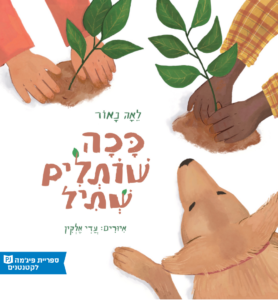 This is How We Plant a Seedling
This is How We Plant a Seedling 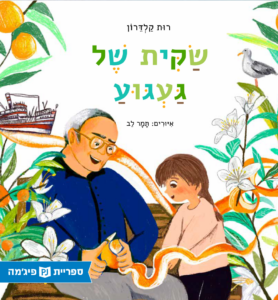 A Bag of Longing
A Bag of Longing 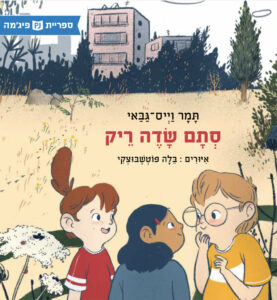 Just an Empty Field
Just an Empty Field 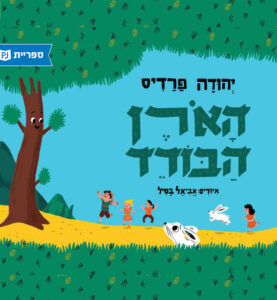 The Lonely Pine Tree
The Lonely Pine Tree 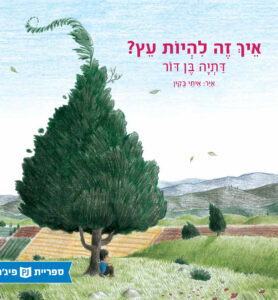 What’s it like to be a Tree?
What’s it like to be a Tree? 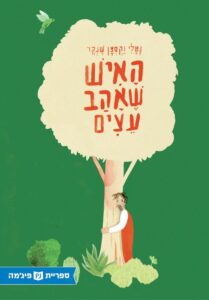 The Man who Loved Trees
The Man who Loved Trees 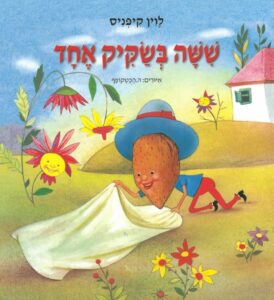 Six in a Bag
Six in a Bag 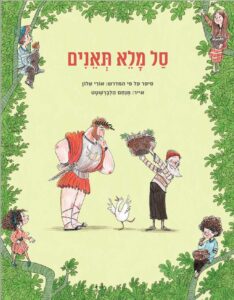 A Basket Full of Figs
A Basket Full of Figs 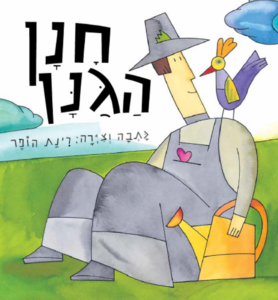 Hannan the Gardener
Hannan the Gardener 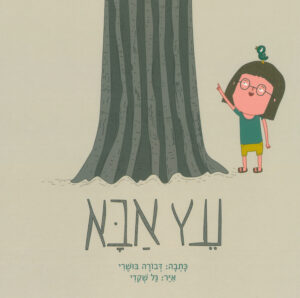 The Daddy Tree
The Daddy Tree 


